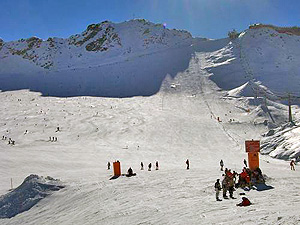
Val Senales (Schnalstal) valley is situated on the north of Italy's Alto Adige (Süd Tirol) region, 65 km away from the region's centre of Bolzano and 40 km away from Merano. The highway ends close to Merano and at the beginning of Val Venosta (Vinschgau) valley, known for its carefully tended apple plantations. The road then takes us to the town of Naturno near which we pass through the tunnel taking us to Val Senales valley and a completely different world isolated from the main road and the fuss of tourist life. Over the entrance to the valley there is an old castle called Juval, owned by a well known alpinist Reinhold Messner. Steep and winding road further takes us on a descent from 850 to 1700 m above seal level, where the village of Vernago with a large accumulation lake is situated. Somewhat further, close to the Val Senales valley, Maso Corto village is situated on an altitude of 2011 m.
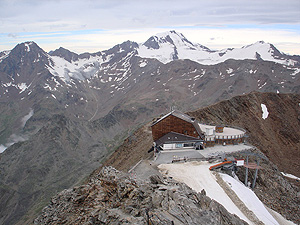 During winter Val Senales turns into a quiet family ski resort with 35 km of trails for alpine skiing, 10 km for cross-country skiing and 5 km for winter hiking. The highest ski trails start at the glacier, on an altitude of 3212 m, and descend all the way to Masso Corto. Alpine skiers have at their disposal 9 km of blue, 12 km of red, and 14 km of black trails. The resort's attraction is a black trail called The Smuggler's run, which i s8 km long and descends from the glacier to the village. There is also a snowboard park on the glacier, so everyone will find something for themselves. Beginners' trails are situated right next to gondola's lower station and equipped with surface lifts, while most of the rest of the trails have chair lifts. Glacier has two surface lifts and one chair lift. Val Senales is special for its panoramic Grawand hotel, situated on the glacier next to the gondola's upper station at an altitude of 3212 m. The hotel and the gondola are the highest ones in the Alto Adige region. Within the hotel there is a pool overlooking the mountain peaks. It is opened from October to May.
During winter Val Senales turns into a quiet family ski resort with 35 km of trails for alpine skiing, 10 km for cross-country skiing and 5 km for winter hiking. The highest ski trails start at the glacier, on an altitude of 3212 m, and descend all the way to Masso Corto. Alpine skiers have at their disposal 9 km of blue, 12 km of red, and 14 km of black trails. The resort's attraction is a black trail called The Smuggler's run, which i s8 km long and descends from the glacier to the village. There is also a snowboard park on the glacier, so everyone will find something for themselves. Beginners' trails are situated right next to gondola's lower station and equipped with surface lifts, while most of the rest of the trails have chair lifts. Glacier has two surface lifts and one chair lift. Val Senales is special for its panoramic Grawand hotel, situated on the glacier next to the gondola's upper station at an altitude of 3212 m. The hotel and the gondola are the highest ones in the Alto Adige region. Within the hotel there is a pool overlooking the mountain peaks. It is opened from October to May.
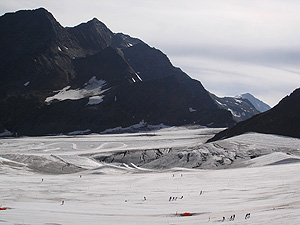 The glacier is opened for skiers and boarders during summer as well, with 4-7 km of operating trails, depending on the condition and the depth of the snow cover. In summer, the following trails are operating: two blue trails (Finail 1 and 2) of 1.5 km length each, with surface lifts; two red trails (Grawand 1 and 2) of 850 m length, and one blue, 1000 m long trail named Grawand 3. All three Grawand trails are equipped with a joint 4-seater lift whose lower station is situated a bit uphill, which may pose problem for snowboarders, since they have to take the lift to get to the snowpark.
The glacier is opened for skiers and boarders during summer as well, with 4-7 km of operating trails, depending on the condition and the depth of the snow cover. In summer, the following trails are operating: two blue trails (Finail 1 and 2) of 1.5 km length each, with surface lifts; two red trails (Grawand 1 and 2) of 850 m length, and one blue, 1000 m long trail named Grawand 3. All three Grawand trails are equipped with a joint 4-seater lift whose lower station is situated a bit uphill, which may pose problem for snowboarders, since they have to take the lift to get to the snowpark.
A self service restaurant with good food and affordable prices is situated next to the upper gondola station. Also, there is a permanent exhibition on the genesis of glaciers and the Alps. Near upper gondola station, there is an exhibition on Ötzi the Iceman whose well preserved mummy was found in the Schnalstal glacier in the Ötztal Alps. During summer you can also visit an ice cave to which you will be taken in a special snowcat with a passenger cabin. You also mustn't miss the ascent to the Grawand peak (3251 m), situated close to the upper gondola's station. It takes 5 mins of walking up a trail with stone stairs and handrails. Once you reach the top of the Grawand peak, you'll be rewarded with a breathtaking view of mountain peaks in the natural park of the Texel mountain group and Ötztaler Alps in Austria. During summer, ski trails are operating from 7:30 a.m. – 13:00 p.m., and you can take the gondola from 7:30 a.m. – 16:30 p.m. One day ski lift pass during summer costs EUR 27 + EUR 5 deposit for a key card.
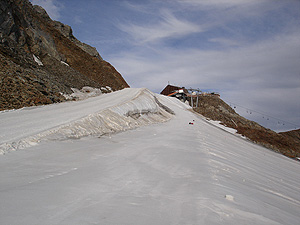 If you cannot imagine your skiing without having a swimming pool close by, you'll be pleasantly surprised at the fact that there are thermae in the near town of Naturno, as well as in somewhat more distant town of Merano. Naturno thermae are more fun oriented, while those in the town of Merano are intended for those who are into wellness. In the town of Merano, there is also the Trauttmansdorff castle, which served as winter residence for empress Elizabeth, better known as Sissi, and is surrounded by beautiful gardens that are best to visit during summer and spring. On the way between the towns of Naturno and Merano, there is the town of Frost with its well known 150 years old brewery and ale-house. You should by all means also visit the town of Bolzano, the center of Alto Adige region, and enjoy its beautiful architecture.
If you cannot imagine your skiing without having a swimming pool close by, you'll be pleasantly surprised at the fact that there are thermae in the near town of Naturno, as well as in somewhat more distant town of Merano. Naturno thermae are more fun oriented, while those in the town of Merano are intended for those who are into wellness. In the town of Merano, there is also the Trauttmansdorff castle, which served as winter residence for empress Elizabeth, better known as Sissi, and is surrounded by beautiful gardens that are best to visit during summer and spring. On the way between the towns of Naturno and Merano, there is the town of Frost with its well known 150 years old brewery and ale-house. You should by all means also visit the town of Bolzano, the center of Alto Adige region, and enjoy its beautiful architecture.
This part of Alto Adige region is "alive" throughout the year, rewarding you with some stunning beauties, such as, for example, a spring drive through 50 km of Val Venostan apple plantations in bloom, while your look also catches beautiful castles and snow-covered mountain peaks.
www.ski-mag.com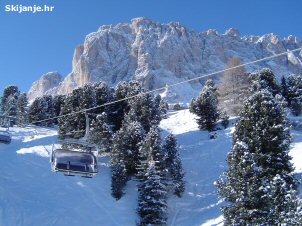
 First, about the name ... The ski resort consists of two parts, Val Gardena and Alpe di Siusi, connected with one skipass and a bus connection. Val Gardena consists of three villages: Selva, St. Cristina and Ortisei, while Castelrotto, Siusi and Fie belong to the Alpe di Siusi. The valley is inhabited with Ladin natives and also Germanic influence is notable, so all the villages have trilingual names: Italian, German and Ladin (Val Gardena = Gröden in German, Gherdëina in Ladin).
First, about the name ... The ski resort consists of two parts, Val Gardena and Alpe di Siusi, connected with one skipass and a bus connection. Val Gardena consists of three villages: Selva, St. Cristina and Ortisei, while Castelrotto, Siusi and Fie belong to the Alpe di Siusi. The valley is inhabited with Ladin natives and also Germanic influence is notable, so all the villages have trilingual names: Italian, German and Ladin (Val Gardena = Gröden in German, Gherdëina in Ladin).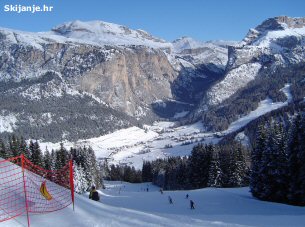 Slopes are very well prepared every night; problems with snow are unknown because of 85% coverage with snow guns. Since the tracks are located on the green pastures, only the minimum amount of snow is sufficient for their preparation. As for freeriders and snowboarders, it appears that this is not their destination, although there are potentials.
Slopes are very well prepared every night; problems with snow are unknown because of 85% coverage with snow guns. Since the tracks are located on the green pastures, only the minimum amount of snow is sufficient for their preparation. As for freeriders and snowboarders, it appears that this is not their destination, although there are potentials.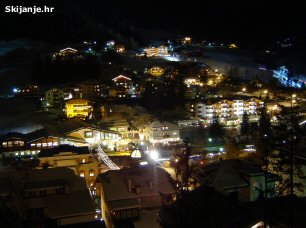 There are no significant crowds on the ski lifts; resort is big enough to "swallow" large number of skiers. Ronda Express, underground train beneath St. Cristina, quickly and efficiently connects two sides of the ski resort, while in Ortisei, the moving staircase helps tired legs from the slopes to the center of the town.
There are no significant crowds on the ski lifts; resort is big enough to "swallow" large number of skiers. Ronda Express, underground train beneath St. Cristina, quickly and efficiently connects two sides of the ski resort, while in Ortisei, the moving staircase helps tired legs from the slopes to the center of the town.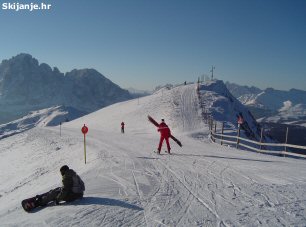 Accommodation is slightly more expensive in Val Gardena then in Alpe di Siusi. Events like the World Cup races raise the prices and proclaimed wish is to create an exclusive ski resort. Prices of several articles in the ski resort are: EUR 3.5-5 for a beer, EUR 2-3 for a mulled wine, EUR 7-10 for a main course, germknödel at about EUR 4 .
Accommodation is slightly more expensive in Val Gardena then in Alpe di Siusi. Events like the World Cup races raise the prices and proclaimed wish is to create an exclusive ski resort. Prices of several articles in the ski resort are: EUR 3.5-5 for a beer, EUR 2-3 for a mulled wine, EUR 7-10 for a main course, germknödel at about EUR 4 .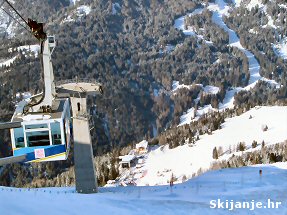
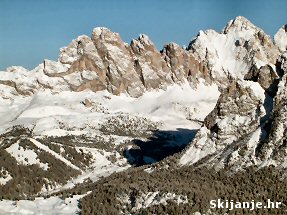 However, the number of 120 km of slopes should be taken with a caution. Ski resort is considerably fragmented: Carezza (or Karersee, on German) has only about 30 km of ski runs, while the rest of the 90 km are assigned to several ski areas such as Belvedere, Ciampac, Col Rodella, Ciampedie or Buffaure. Belvedere and Col Rodella areas over villages of Canazei and Campitello attract most of the crowds. They offer wide, sunny slopes ideal for medium skilled skiers. More importantly, they provide a direct link to the
However, the number of 120 km of slopes should be taken with a caution. Ski resort is considerably fragmented: Carezza (or Karersee, on German) has only about 30 km of ski runs, while the rest of the 90 km are assigned to several ski areas such as Belvedere, Ciampac, Col Rodella, Ciampedie or Buffaure. Belvedere and Col Rodella areas over villages of Canazei and Campitello attract most of the crowds. They offer wide, sunny slopes ideal for medium skilled skiers. More importantly, they provide a direct link to the 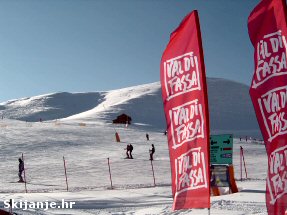 Attention should be paid to the interesting Tomba la Bomba ski run on Ciampedie and Aloch slope which has red and black directions lit for night skiing. Red run can be taken from Belvedere area to the village of Canazei, but beware: you will not end at the foot of the gondola but near the local church. Unless you are willing to take 10 minutes walk back to the gondola we recommend this only for the last run of the day.
Attention should be paid to the interesting Tomba la Bomba ski run on Ciampedie and Aloch slope which has red and black directions lit for night skiing. Red run can be taken from Belvedere area to the village of Canazei, but beware: you will not end at the foot of the gondola but near the local church. Unless you are willing to take 10 minutes walk back to the gondola we recommend this only for the last run of the day. There is not much space for freeriders but you can try ski route down the Sella massif with experienced mountain guide. Cross-country skiing is very popular - 50 km of slopes are available al well as 70-km-long Moena-Canazei-Moena-Cavalese circuit, venue of renowned Marcialonga race.
There is not much space for freeriders but you can try ski route down the Sella massif with experienced mountain guide. Cross-country skiing is very popular - 50 km of slopes are available al well as 70-km-long Moena-Canazei-Moena-Cavalese circuit, venue of renowned Marcialonga race.
 Trevalli (Three valleys, author's remark) lies in the Dolomites, on the border between Veneto and Trentino regions. It is a part of the Dolomiti Superski, a complex of 12 Italian resorts. Three valleys from the resort's name are the regions around Falcade, Passo San Pellegrino and Moena. The resort has 100 km of excellently prepared runs, covered by artificial snowmaking system. The runs descend from 2500 to 1200 m of altitude. However not all of them are connected; the resorts has two main parts - larger one, above Falcade and Passo S. Pellegrino (about 2/3 of the trails' length), and smaller one, above Moena, also known as Alpe Lusia. These two parts are very close, and are connected by a ski bus (about 15 mins ride) which is free of charge. A look at the ski map poses logical question: why isn't the whole resort connected? The reason is that a nature park is situated right between the two parts of the resort, and any kind of human intervention in this area is prohibited. Here, nature preservation is prior to profit.
Trevalli (Three valleys, author's remark) lies in the Dolomites, on the border between Veneto and Trentino regions. It is a part of the Dolomiti Superski, a complex of 12 Italian resorts. Three valleys from the resort's name are the regions around Falcade, Passo San Pellegrino and Moena. The resort has 100 km of excellently prepared runs, covered by artificial snowmaking system. The runs descend from 2500 to 1200 m of altitude. However not all of them are connected; the resorts has two main parts - larger one, above Falcade and Passo S. Pellegrino (about 2/3 of the trails' length), and smaller one, above Moena, also known as Alpe Lusia. These two parts are very close, and are connected by a ski bus (about 15 mins ride) which is free of charge. A look at the ski map poses logical question: why isn't the whole resort connected? The reason is that a nature park is situated right between the two parts of the resort, and any kind of human intervention in this area is prohibited. Here, nature preservation is prior to profit.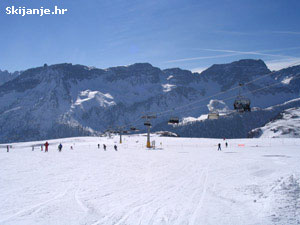 This is primarily family oriented resort, but lately, there is also a reason to for it to be favored by sowboarders. Almost half of the runs are classified as blue. There are three kindergartens on snow for families with children, while boarders have at their disposal three great snow parks. There is also something for most demanding skiers: red, wide runs are made for carving. Also, red and black runs (named "Fiamme Oro" and "Piavac) descending toward the valley in Alpe Lusia Part are not to be missed, as well as the descent from Col Margerita peak that leads toward Passo S. Pellegrino. All the runs are excellently prepared and are in good condition throughout the day, without any bumps as the end of a ski day approaches. Most runs are inclined toward the sun. And speaking of the sun, this resort has it galore. Lovers can enjoy easy 10 km Pista degli Innamorati (Lovers' run) that runs through beautiful snowy scenery. Great impression will be completed by a tasteful domestic meal at some of sun bathed terraces.
This is primarily family oriented resort, but lately, there is also a reason to for it to be favored by sowboarders. Almost half of the runs are classified as blue. There are three kindergartens on snow for families with children, while boarders have at their disposal three great snow parks. There is also something for most demanding skiers: red, wide runs are made for carving. Also, red and black runs (named "Fiamme Oro" and "Piavac) descending toward the valley in Alpe Lusia Part are not to be missed, as well as the descent from Col Margerita peak that leads toward Passo S. Pellegrino. All the runs are excellently prepared and are in good condition throughout the day, without any bumps as the end of a ski day approaches. Most runs are inclined toward the sun. And speaking of the sun, this resort has it galore. Lovers can enjoy easy 10 km Pista degli Innamorati (Lovers' run) that runs through beautiful snowy scenery. Great impression will be completed by a tasteful domestic meal at some of sun bathed terraces. As for accommodation, the resort has a capacity of some 15000 beds. More affordable arrangements can be booked in neighboring places such as Agordo, Cencenighe or Canale d'Agordo. The prices at the resort are the following: goulash - around EUR 7, lasagne - EUR 6, beer - EUR 3-5, grappa - around EUR 2. After taking off your skis, you can have fun at skating rinks, pools, pizzerias (recommendation: "Da Silvio" in Agordo) etc. You can experience somewhat livelier apres ski fun in Moena, while Falcade is a more peaceful place where fun takes place in restaurants and pubs.
As for accommodation, the resort has a capacity of some 15000 beds. More affordable arrangements can be booked in neighboring places such as Agordo, Cencenighe or Canale d'Agordo. The prices at the resort are the following: goulash - around EUR 7, lasagne - EUR 6, beer - EUR 3-5, grappa - around EUR 2. After taking off your skis, you can have fun at skating rinks, pools, pizzerias (recommendation: "Da Silvio" in Agordo) etc. You can experience somewhat livelier apres ski fun in Moena, while Falcade is a more peaceful place where fun takes place in restaurants and pubs.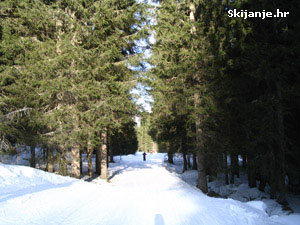 Owing to its very good position and good traffic linkage, our recommendation is to use Trevalli as a base for a ski week in the Dolomites. Nearby are excellent resorts such as
Owing to its very good position and good traffic linkage, our recommendation is to use Trevalli as a base for a ski week in the Dolomites. Nearby are excellent resorts such as 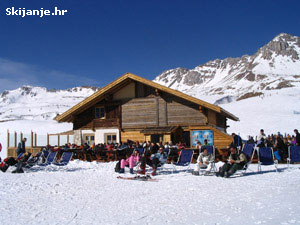
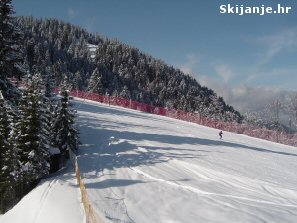
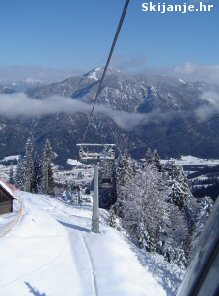 Friuli-Venezia-Giulia is the easternmost region of Italy, which also borders with Slovenia and Austria. Intertwining of Roman, German and Slavic culture on this small area developed specific and rich tradition with deep bonds between people and, inevitably, cooperation that is now to the satisfaction of visitors manifested primarily in integrated tourism offer. Popular tourist and ski destinations are settled in rhe area: Kranjska Gora in Slovenia, or Nassfeld in Austria. On the Italian side there is Tarvisio, a small and charming ski resort.
Friuli-Venezia-Giulia is the easternmost region of Italy, which also borders with Slovenia and Austria. Intertwining of Roman, German and Slavic culture on this small area developed specific and rich tradition with deep bonds between people and, inevitably, cooperation that is now to the satisfaction of visitors manifested primarily in integrated tourism offer. Popular tourist and ski destinations are settled in rhe area: Kranjska Gora in Slovenia, or Nassfeld in Austria. On the Italian side there is Tarvisio, a small and charming ski resort.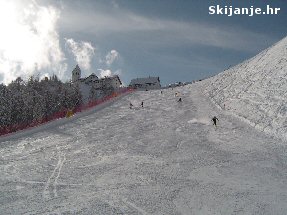 There have been major investments in the infrastructure during last seasons, so much of the older ski lifts are now substituted with modern ones. Entire resort is covered by the artificial snow making system. Parking, right next to the major ski lift, is free. Ski rent and ski instructors are available at the bottom of the hill. There is a sufficient number of restaurants and bars where you can stop and rest tired legs. All the slopes are interconnected; the only time you'll have to take off your skis is while crossing a mountain road. Only 20 km away is another ski resort, Sella Nevea, for those wanting a little change in scenery.
There have been major investments in the infrastructure during last seasons, so much of the older ski lifts are now substituted with modern ones. Entire resort is covered by the artificial snow making system. Parking, right next to the major ski lift, is free. Ski rent and ski instructors are available at the bottom of the hill. There is a sufficient number of restaurants and bars where you can stop and rest tired legs. All the slopes are interconnected; the only time you'll have to take off your skis is while crossing a mountain road. Only 20 km away is another ski resort, Sella Nevea, for those wanting a little change in scenery.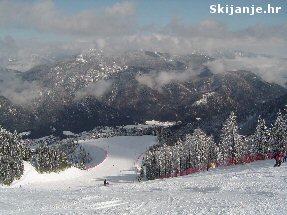 Daily skipass costs EUR 30 and 6-day skipass is EUR 132. Sci@ore or skiing for a few hours is also possible if you buy only limited number of ski hours per day or per season.
Daily skipass costs EUR 30 and 6-day skipass is EUR 132. Sci@ore or skiing for a few hours is also possible if you buy only limited number of ski hours per day or per season.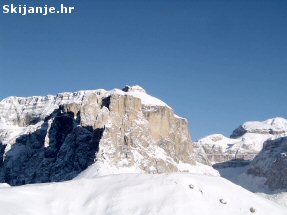
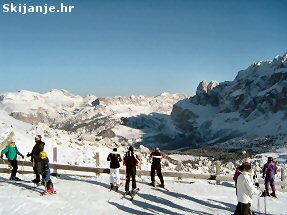 You can start your tour by taking the ski lifts in any of the four villages - Alta Badia's Corvara, Val Gardena's Selva/Wolkenstein, Val di Fassa's Canzei, or Arabba. In case you decide on following the orange arrows, you'll be doing the clockwise route. If you follow the green arrows, you're on the anti-clockwise route. Each route consists of at least 23 km of ski runs and 14-16 km of ski lifts. The runs are of a moderate difficulty level. Nevertheless, the slopes are located at high altitudes, and we're speaking of many kilometers here, so the tour is recommended to more experienced skiers in good physical shape.
You can start your tour by taking the ski lifts in any of the four villages - Alta Badia's Corvara, Val Gardena's Selva/Wolkenstein, Val di Fassa's Canzei, or Arabba. In case you decide on following the orange arrows, you'll be doing the clockwise route. If you follow the green arrows, you're on the anti-clockwise route. Each route consists of at least 23 km of ski runs and 14-16 km of ski lifts. The runs are of a moderate difficulty level. Nevertheless, the slopes are located at high altitudes, and we're speaking of many kilometers here, so the tour is recommended to more experienced skiers in good physical shape.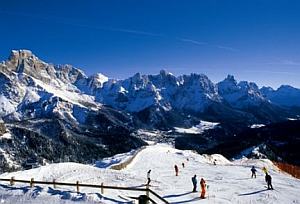
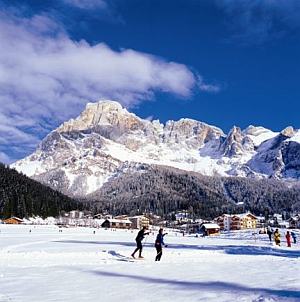 San Martino di Castrozza is a picturesque ski resort situated in the Italian Dolomites, right in the heart of the national park Peneveggio Pale di San Martino, whose beauty will certainly not leave anyone indifferent. Except for unforgettable views of the Cimon della Pala (3,184 m), Rosetta (2,743 m), Pale di S. Martino (2,982) and Vezzana (3,192 m) peaks, located amphitheatrically around the village, a national park is well known for its extremely rich and dense black forests, the house of many wild animals.
San Martino di Castrozza is a picturesque ski resort situated in the Italian Dolomites, right in the heart of the national park Peneveggio Pale di San Martino, whose beauty will certainly not leave anyone indifferent. Except for unforgettable views of the Cimon della Pala (3,184 m), Rosetta (2,743 m), Pale di S. Martino (2,982) and Vezzana (3,192 m) peaks, located amphitheatrically around the village, a national park is well known for its extremely rich and dense black forests, the house of many wild animals.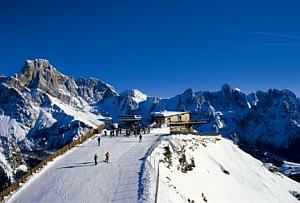 The ski resort is a part of the Dolomiti Superski carousel which is a guarantee of quality for itself. There is about 45 km of ski slopes, almost entirely connected, except for the part under the peak of Cimon della Pala and Rosetta. Below these two rocks Col Verde slope is set, fully lit for night skiing. The slope bears a red mark, but in the upper part has blue and red variation. On top of Col Verde there is a restaurant and a departure point of a gondola that goes under the very top of Rosetta, where an unforgettable view can be admired and another restaurant is available. Only way down from here is with the gondola again since no prepared ski runs exist.
The ski resort is a part of the Dolomiti Superski carousel which is a guarantee of quality for itself. There is about 45 km of ski slopes, almost entirely connected, except for the part under the peak of Cimon della Pala and Rosetta. Below these two rocks Col Verde slope is set, fully lit for night skiing. The slope bears a red mark, but in the upper part has blue and red variation. On top of Col Verde there is a restaurant and a departure point of a gondola that goes under the very top of Rosetta, where an unforgettable view can be admired and another restaurant is available. Only way down from here is with the gondola again since no prepared ski runs exist.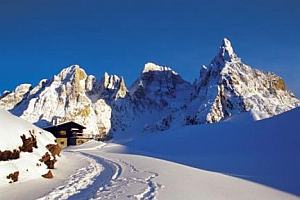 A word about the main ski area... San Martino has 9 chairlifts, 3 gondolas (2 of them on the above mentioned separate area) and 4 ski lifts. Slopes stretch on the 3 major hills - Punta Ces (2,227 m), Cima Tognola (2,383 m) and Tognola (2,220 m). All of them are connected by very ancient ski lifts. Several decades old Leitner lifts would not be such a problem if they were not so long, making you bored during the ride. Red runs dominate the ski resort. Areas around Malga Cesa and Tognola are suitable for learning the first ski steps. Only two black runs exist, one called "Direttissima" that connects to the red run and other "Tognola 1" set right underneath the gondola that runs to the peak of Tognola. Slopes are rather narrow, but well prepared and maintained. The only objection could be pointed at poor slope marking which can impede skiing during the bad weather. Skiers used to signpost with numbers of the slopes might be disappointed because the numbers can be found on the maps, but not on the courses.
A word about the main ski area... San Martino has 9 chairlifts, 3 gondolas (2 of them on the above mentioned separate area) and 4 ski lifts. Slopes stretch on the 3 major hills - Punta Ces (2,227 m), Cima Tognola (2,383 m) and Tognola (2,220 m). All of them are connected by very ancient ski lifts. Several decades old Leitner lifts would not be such a problem if they were not so long, making you bored during the ride. Red runs dominate the ski resort. Areas around Malga Cesa and Tognola are suitable for learning the first ski steps. Only two black runs exist, one called "Direttissima" that connects to the red run and other "Tognola 1" set right underneath the gondola that runs to the peak of Tognola. Slopes are rather narrow, but well prepared and maintained. The only objection could be pointed at poor slope marking which can impede skiing during the bad weather. Skiers used to signpost with numbers of the slopes might be disappointed because the numbers can be found on the maps, but not on the courses. Ski area on mountain pass Passo Rolle is considered a part of San Martino di Castrozza ski resort, too. Although the slopes are not connected with the ones of San Martino, it is worth coming (only by car, no ski bus here) for beautiful runs served by four chairlifts and two lifts. With Passo Rolle, there is 60 km of ski slopes in San Martino di Castrozza.
Ski area on mountain pass Passo Rolle is considered a part of San Martino di Castrozza ski resort, too. Although the slopes are not connected with the ones of San Martino, it is worth coming (only by car, no ski bus here) for beautiful runs served by four chairlifts and two lifts. With Passo Rolle, there is 60 km of ski slopes in San Martino di Castrozza.